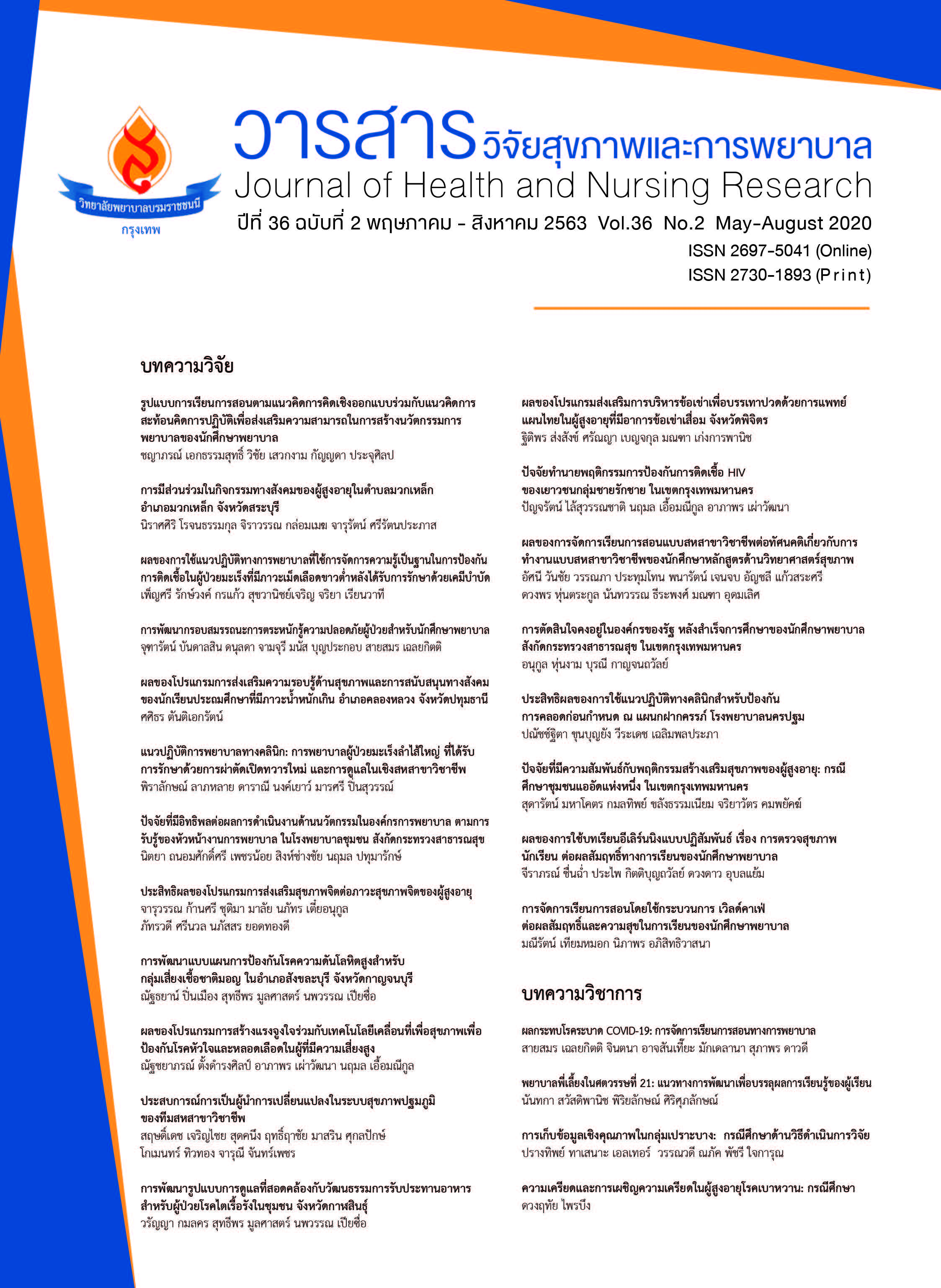ผลของโปรแกรมการสร้างแรงจูงใจร่วมกับเทคโนโลยีเคลื่อนที่เพื่อสุขภาพเพื่อป้องกันโรคหัวใจและหลอดเลือดในผู้ที่มีความเสี่ยงสูง
คำสำคัญ:
กลุ่มเสี่ยงสูงต่อการเกิดโรคหัวใจและหลอดเลือด, เทคโนโลยีเคลื่อนที่เพื่อสุขภาพ, แรงจูงใจในการป้องกันโรค, โปรแกรมไลน์, พฤติกรรมการป้องกันโรคหัวใจและหลอดเลือดบทคัดย่อ
การศึกษาครั้งนี้เป็นการวิจัยเป็นแบบกึ่งทดลอง (Quasi-experimental research) เพื่อศึกษาผลของโปรแกรมการสร้างแรงจูงใจร่วมเทคโนโลยีเคลื่อนที่เพื่อสุขภาพเพื่อป้องกันโรคหัวใจและหลอดเลือดในผู้ที่มีความเสี่ยงสูง วัยสูงอายุทั้งเพศชายและหญิงที่มีผลการประเมิน Thai CV Risk score ตั้งแต่ร้อยละ 20.00 ขึ้นไป จำนวน 60 คน แบ่งเป็นกลุ่มทดลอง 30 คน และกลุ่มเปรียบเทียบ 30 คน โดยกลุ่มทดลองจะได้รับโปรแกรมการสร้างแรงจูงใจ ซึ่งพัฒนาภายใต้ทฤษฎีแรงจูงใจในการป้องกันโรคร่วมกับการใช้เทคโนโลยีเคลื่อนที่เพื่อสุขภาพ โปรแกรมนี้ใช้เวลา 4 สัปดาห์ มีกิจกรรมหลักสำคัญ คือ การให้ความรู้รายกลุ่ม การฝึกทักษะรายบุคคล การเรียนรู้จากบุคคลต้นแบบ ร่วมกับการให้ข้อมูล infographic และวิดีโอผ่านโปรแกรมไลน์ โดยมีการเก็บรวบรวมข้อมูลจากการตอบแบบสอบถามด้วยตนเองของผู้เข้าร่วมการวิจัยใน 3 ระยะ คือ ก่อนการทดลอง หลังการทดลองทันที และระยะติดตามผลหลังการทดลอง 1 เดือน แล้วนำมาวิเคราะห์ข้อมูลด้วยสถิติ ค่าความถี่ ร้อยละ ค่าเฉลี่ย ส่วนเบี่ยงเบนมาตรฐาน Chi-square, Independent t-test ,One way repeated measure ANOVA และ Bonferroni
ผลการศึกษาพบว่าคะแนนเฉลี่ยด้านการรับรู้ความรุนแรงของการเกิดโรคของกลุ่มทดลองในระยะติดตามผลดีขึ้นกว่าก่อนการทดลองและหลังการทดลอง (Mean=15.60, SD. = 2.08 ), (Mean =13.70, SD. = 1.37), (Mean =14.07, SD. = 1.82) อย่างมีนัยสำคัญทางสถิติ (p < .001) และคะแนนเฉลี่ยระหว่างกลุ่มของกลุ่มทดลองในด้านการปฏิบัติพฤติกรรมการป้องกันโรคหัวใจและหลอดเลือดสูงกว่ากลุ่มเปรียบเทียบในระยะหลังการทดลองและติดตามผล (t= 3.02 p = .004), (t= 2.88, p = .006) แสดงให้เห็นว่าโปรแกรมการสร้างแรงจูงใจที่อาศัยเทคโนโลยีเคลื่อนที่เพื่อสุขภาพร่วมกับการให้ info graphic สามารถส่งเสริมพฤติกรรมการป้องกันโรคหัวใจและหลอดเลือดในผู้ที่มีความเสี่ยงสูงได้ และสามารถนำไปปรับใช้ให้เหมาะสมกับกลุ่มเสี่ยงต่อการเกิดโรคหัวใจและหลอดเลือดในแต่ละพื้นที่ ซึ่งจะช่วยป้องกันการเกิดผู้ป่วยโรคหัวใจและหลอดเลือดรายใหม่ในอนาคตได้
Downloads
เอกสารอ้างอิง
World Health Organization. Noncommunicable Diseases (NCD) Country Profiles. In: Profiles NDNC, editor.: World Health Organization; 2014.
American Diabetes Association. Cardiovascular Disease and Risk Management. Diabetes Care. 2015;38(Supplement 1):S49-S57
World Health Organization. HEARTS Technical package for cardiovascular disease management in primary health care. Switzerland: WHO Document Production Services; 2016. p. 73.
Bureau of Non Communicable Disease. Annual Report 2016. Nonthaburi: Bureau of Non Communicable Disease Department of Disease Control Ministry of Public Health; 2016.
Strategy and Planning Division. Public Health Statistics A.D.2015. Bangkok. Samcharoen Panich Co.,Ltd.; 2016 (in Thai)
Phayamengrai Hospital. Thailand healthy lifestyle [Power point]. 2017[cite 2017 Aug 31].
World Health Organization. Cardiovascular disease risk factors [Book]. 2011[cited 2018 Aug 31]. Available from: http://www.world-heartfederation.org/press/fact-sheets/cardiovascular-disease-risk-factors/.
Pichayapinyo P, Lagampan P, Sujirarat D, Kaewpan W. Factors Associated with Behavior in Diabetic patient with Risk of Cardiovascular Disease. [Book] 2015. [cited 2017 Sep 15]. Available from: http://kb.hsri.or.th/dspace/handle/11228/4386?locale-attribute=th
Ebrahim S, Taylor F, Ward K, Beswick A, Burke M, Davey SG. Multiple risk factor interventions for primary prevention of coronary heart disease [Internet]. 2011[cited 2017 Sep 15]. Available from: https://www.cochranelibrary.com/cdsr/doi/ 10.1002/14651858.CD001561.pub3/full
Deitz D, Cook RF, Hersch RK, Leaf S. Heart healthy online: an innovative approach to risk reduction in the workplace. J Occup Environ Med. 2014;56(5):547-53.
Watcharasin S, Pakdeepinit A, Aapsuwan N. Behavior modification in the clinic manual NCD quality. Nonthaburi: The agricultural Co- operative Federation of Thailand, LTD; 2015. (in Thai)
Mano A, Kaewpan W, Powwattana A, Pichayapinyo P. The Effectiveness of the Application of the Protection Motivation Theory and Social Support in Hypertension Prevention Program Among Middle-aged Men in Bangkok Metropolitan. Journal of Health and Nursing Research (Journal of Boromarajonani College of Nursing, Bangkok) [internet],2011[cited 2018 May 18];28(1) Available from: https://www.tci-thaijo.org /index.php/ bcnbangkok/article/view/4842. (In Thai)
Leamtong B, Rawiworrakul T, Srisorrachatr S. Effects of the Protection Motivation Theory Application Program on Health Promotion Behavior among Hypertentive Risk Group Royal Thai Air Force. The Journal of Faculty of Nursing Burapha University 2011;19(4):61-71. (in Thai).
Sirpha W. The application of the protection motivation theory and social support for improving health behavior of diabetes mellitus patients in Sophisai district, Buengkan province. Journal of Nursing and Health Sciences 2014;8(3):268-78. (in Thai).
Wongsuwan P, Teangtham W, Powwattana A, Nanthamongkolchai S. Health promotion program for complication prevention among the elderly with hypertension in Bangkok. Journal of Public Health Nursing 2016;28(3):145-60. (in Thai).
Thimoonnee M, Prechawong S. Factors related to preventive behaviors for cardiovascular disease
in premenopausal cleaning personnel. Kuakarun Journal of Nursing 2016;23(1):118-32.
Yingyaun K, Methakanjanasak N. Self -Management Telehealth Innovation for Patients with
Diabetes Mellitus Type 2 with Dyslipidemia. Srinagarind Med J 2016;31(6):365-71.
Piette JD, List J, Rana GK, Townsend W, Striplin D, Heisler M. Mobile Health Devices as Tools
for Worldwide Cardiovascular Risk Reduction and Disease Management. Circulation. 2015;132(21):
-27
Redfern J, Usherwood T, Harris MF, Rodgers A, Hayman N, Panaretto K, et al. A randomised
controlled trial of a consumer-focused e-health strategy for cardiovascular risk management
in primary care: the Consumer Navigation of Electronic Cardiovascular Tools (CONNECT) study
protocol. BMJ Open 2014;4(2).
Electronic Transactions Development Agency. Thailand Internet User Profile 2016[internet].2016
[cited 2018 May 31] Available from: https://www.etda.or.th/publishing-detail/thailandinternet-
user-profile-2016-th.html.
Boer HS. E.R. protective motivative theory. In: In M. Conner PN, editor. Predicting Health Behaviour:
Research and Practice with Social Cognition Models. Buckingham 1996. p. 95-122.
Rogers RW, Prentice-Dunn S. Protection motivation theory. Handbook of health behavior
research 1: Personal and social determinants. New York, NY, US: Plenum Press; 1997. p. 113-32.
Klinaruenart K, Auemaneekul N, Rawiworrakul T, Silpasuwan P. The Application of Protection
Motivation Theory for Coronary Artery Prevention Program for Teachers. Siriraj Nursing Journal
;7(2):39-51.
Cohen, J. Statistical power analysis for the behavioral sciences. N.J: L. Erlbaum Associates: Hillsdale;
Bauthong S, Saphawat S, Jittijarat S. Ageing related to reason method and needs of learning.
Journal of Education, Silpakorn University. 2014 – 2015;12(1,2):6-17.
Ploykaew J, Chomson S. The effect of motivation program on health behaviors among risk
group diabetes mellitus [Internet].2017[cited 2017 Nov 17]. Available from: http://www.northern.
ac.th/north_research/p/document/ file_14909406070.doc
Watchjakwane N. Satheannoppakao W, Terncharoen, Pandii W. Nutrition promotion program for
physiological risk prevention of cardiovascular disease in pre-menopause women. Thai Journal
of Public Health 2010;40(1):40-52.
Bunyun S. Rerated Factors of Coronary Artery Disiease And Stroke in Diabetes Speciallity cinic
in Phaisali Hospital Phaisali District Nakhon Sawan Province. Journal of Preventive Medicine
Association of Thailand 2016;6(3):256-66.
Thai Hypertension Society. 2019 Thai Guidelines on The Treatment of Hypertension. Bangkok:
Thai Hypertension Society; 2019. (in Thai)
ดาวน์โหลด
เผยแพร่แล้ว
รูปแบบการอ้างอิง
ฉบับ
ประเภทบทความ
สัญญาอนุญาต
บทความที่ได้รับการตีพิมพ์ เป็นลิขสิทธิ์ของวารสารวิจัยสุขภาพและการพยาบาล (วิทยาลัยพยาบาลบรมราชชนนี กรุงเทพ) ไม่สามารถนำไปตีพิมพ์ซ้ำในวารสารฉบับอื่น


















